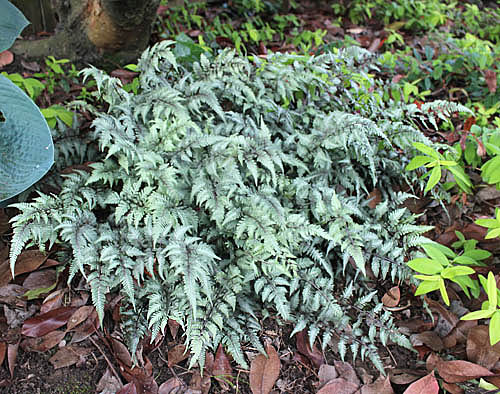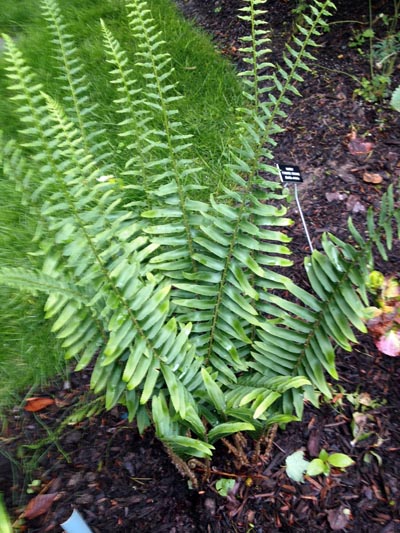Ferns: Not To Be Ignored
By George Graine, Fairfax Master Gardener
 “The bright colours of flowers are admired by the least intellectual but the beauty of form and texture requires a higher degree of mental perception, and a more cultivated intellect for its proper appreciation. Hence we regard the growing taste for the cultivation of ferns as proof of mental advancement.” From a fern catalogue issued in 1858 by fern nurseryman Abraham Stansfield; encomium by John Palmer
“The bright colours of flowers are admired by the least intellectual but the beauty of form and texture requires a higher degree of mental perception, and a more cultivated intellect for its proper appreciation. Hence we regard the growing taste for the cultivation of ferns as proof of mental advancement.” From a fern catalogue issued in 1858 by fern nurseryman Abraham Stansfield; encomium by John Palmer
Hopefully, reading this quote does not offend you especially when you consider that it was written 163 years ago. Of course, we know that ferns are not big flowering show stoppers that take your breath away. For example, hibiscus, peony, roses and hydrangea all fit into that category. If you think ferns are plants that only belong in yesteryear gardens, please read on. A new book, “The Complete Book of Ferns” by Mobee Weinstein (Cool Springs Press, 2020), should help change such a mindset. Just because some people often consider ferns to be unassuming does not mean they should be relegated to some far away and barely seen dark corner of your landscape.
For sure, ferns are not show-off plants. The simplicity of ferns is their most attractive attribute. How can ferns compete with magnificent floral displays? The answer is because ferns have many uses in the garden. To be clear, fern varieties provide gardeners with different sizes, shapes and colors beyond shades of green. Some are evergreen and others deciduous. Once you realize that ferns have many uses, your concerns about having boring and/or simple plants should no longer be an issue. Heretofore, you may have had an unrealized appreciation of ferns, and you may have only paused briefly at garden center fern tables. Then, perhaps a thought occurred to you that adapting ferns into your landscape could be a game changer. Surely, with the introduction of these plants you will create a new and different planting scheme.
Recently, ferns are undergoing what some may call a modern renaissance. Indeed the variety of ferns will surely surprise you with their diversity. Although ferns have been around for hundreds of millions of years, you will realize they are complex plants. Just as newly introduced plants are marketed by growers each year (think plant du jour) so too there are new ferns being propagated and brought to the retail trade. The difference between a new variety and a similar plant is not often discernable. You might take this up with a pteridologist, a fern specialist.
Chapter 2 on The Botany of Ferns includes an easy to understand explanation about these plants. If you are interested in propagating ferns through using their spores (not seeds), this is not a difficult procedure. It can be a fun experience and the DIY step-by-step pages in the book provide ample explanation leading to your success.

Japanese Painted Fern

Christmas Fern
After reading about indoor and outdoor ferns, there is something else you should consider. For a different look, the last chapter explains Do-It-Yourself Crafting with Ferns and how they could become a new and different reality for you. In other words, how to turn ferns into art objects. This is a fun chapter because it allows you to take on a different dimension regarding ferns. You will also learn about creative planning projects and be inspired by the many ways that will enhance how your ferns appear in the garden. Some of the ideas, all presented in detail, include step-by-step instructions with excellent color photos for each step in the process. Several examples include terrarium variations, the new trend in vertical gardens, dish gardens and tabletop gardens. These ideas should help get your creative juices flowing.
Have you heard about Kokedama? If so, then you know this is a centuries old Japanese art form that is related to bonsai. The English translation means “moss ball.” All you need to know about crafting a display for a tabletop or hanging Kokedama is clearly spelled out in words and photos. Also in the crafting chapter are three other projects, all with extensive help. You will learn how to create fern prints, make pressed fern art and cyanotypes. The last project is an old photographic technique from 1842. It is photochemical blueprinting where the process is based on a chemical’s sensitivity to ultraviolet light. Today this process is called Sunprints. If this sounds really technical do not fret because there are a variety of kits available where supplies are sold at craft stores. You can work with pre-treated paper or fabric in assorted colors. This is an easy, exciting and fun project the entire family can enjoy.
So now you know why ferns should not be ignored, whether outdoors in your garden or indoors in your house. Happy “ferning” everybody.